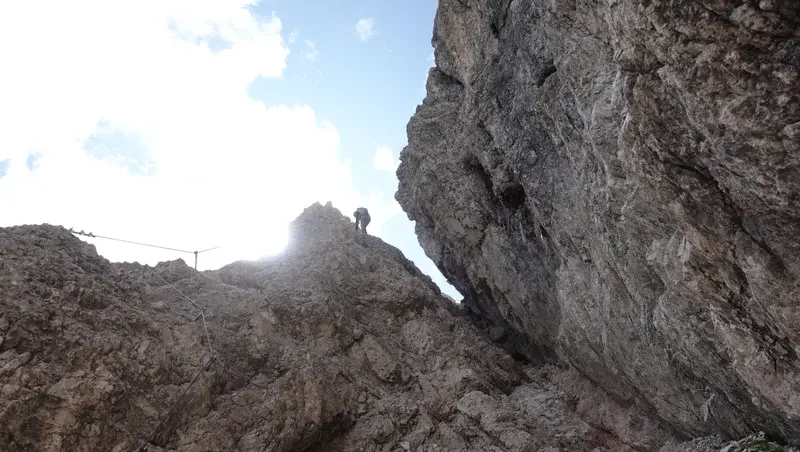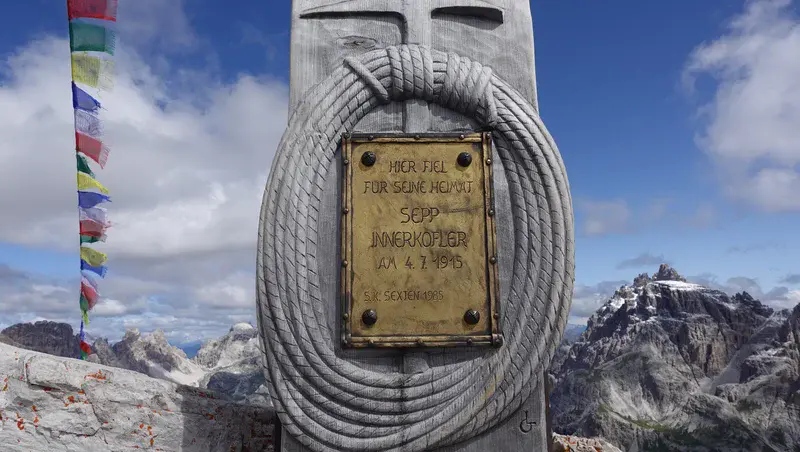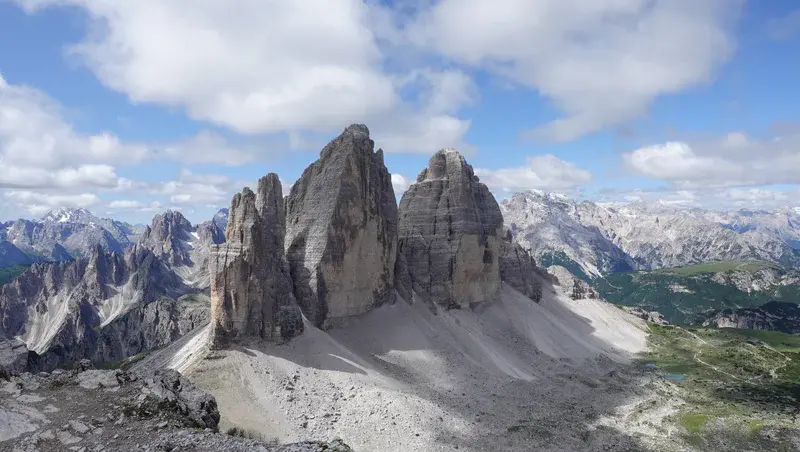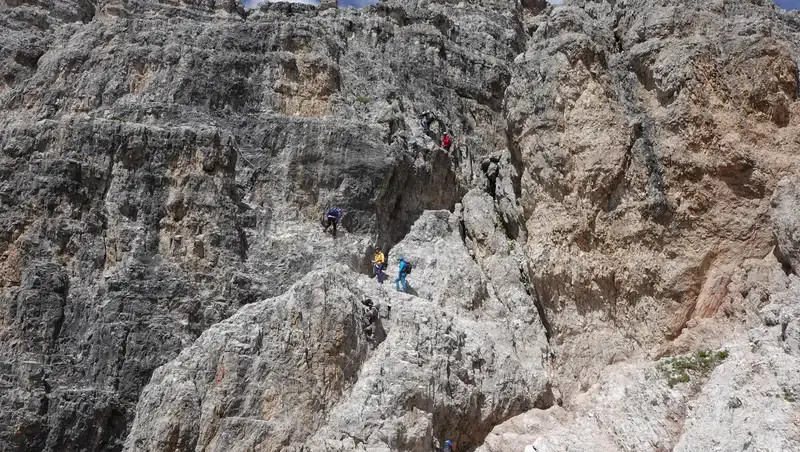Recently, I had a useless discussion on a Facebook group, related to the rating of Monte Paterno Ferrata or Innerkofler Ferrata (also known as the Locatelli Ferrata or Sentiero Luca Innerkofler) in the Dolomites. This motivated me to write this text.

So the text is based on that popular via ferrata route in the Italian Dolomites, but it applies to all of them, and you will realize why.
This particular route starts near the Locatelli Hut (Rifugio Locatelli) in the Sexten Dolomites and ascends to the summit of Monte Paterno (2744 m, 9003 ft). It is a classic high-alpine via ferrata known for its exposed sections, historical significance (named after alpinist Sepp Innerkofler, see the picture), and stunning views of the Tre Cime di Lavaredo.

Somebody asked about the difficulty of the route (link available), and to my surprize, I noticed this reply “That secured path to Monte Paterno can’t even be called a via ferrata”.
I found this a highly dangerous and irresponsible reply, so I commented because I was on the ferrata just a couple of weeks before that.
Then there was somebody else commenting on my reply “It is at best level A”. I tried to explain that the statement had no meaning because there is nothing below A, so this would mean it is not a ferrata at all. In any case, I stopped my participation there and decided to write this text instead as it might be more useful.
What Are Via Ferrata Ratings, Anyway?
I would start with such a description: You are halfway up the Innerkofler Ferrata on Monte Paterno, clinging to a cable on a windswept ridge with the Tre Cime di Lavaredo looming like giants (the photo below). Your guidebook calls this a “moderate” B/C route, manageable for intermediates. Yet, your legs are jelly, the drop below is dizzying.

You check the rating again: B, with some C elements. Really? This is moderate? Yes this is the maddening world of via ferrata ratings, where every scale seems designed to mislead and confuse. Here is why they all suck, and what you can do about it.
Via ferratas rely on ratings to tell you how tough they are. The gold standard is the UIAA scale, set by the International Climbing and Mountaineering Federation.
It runs A (a steep walk) to E (near-vertical insanity), with F for rare, extreme routes that laugh at mere mortals (not to be mixed with the term “facile” and the corresponding F-rating that also exists in some sources to confuse you even more).
But other systems exist too, like the Hüsler scale (K1-K6, used in Germany), or numerical 1-5 grades in some guidebooks.
The idea of all this is to help climbers pick routes matching their skills, gear, and guts. Sounds great until you are on the real mountain and the rating feels like a cruel joke.
The UIAA scale grades are based on fixed protections (cables, ladders), steepness, exposure, and physical demand. On a “B” route like Innerkofler’s main path, cables are plenty, and it requires a moderate effort.
A “C” section below the summit ridge, the picture below, adds exposure and trickier moves (grade II-III).

But these tidy labels unravel fast when you are out there. Let’s break down why.
The Many Ways Ratings Fail
1. They Are Wildly Subjective
What is “moderate” to a seasoned alpinist may be a nightmare for a weekend warrior. The Innerkofler Ferrata, rated B/C in some sources, sounds approachable. By the way, I think this rating is realistic.
But its sheer drops under the summit can spike heart rates to D-level panic for anyone not used to heights.
Fitness, fear tolerance, and prior ferrata experience skew perceptions wildly. Ratings don’t account for your personal breaking point, or lack thereof.
You have seen above how some people see this particular ferrata. In fact, there were more comments, claiming it is perfect for beginners.
My guess is those people where young, from my personal experience, such a level of arrogance frequently goes with the young age. I did mention that my opinion was based on my 40 years of experience, but they were not impressed.
But perhaps they were beginners themselves who climbed the mountain with guides and felt safe and protected. Then they perhaps wrongly assume that this is how people normally do these things. Well, not everybody goes with a guide.
2. Inconsistent Standards Across Regions
The UIAA scale is international, but its application isn’t. Italian Dolomites routes like Innerkofler often feel harder than their Austrian or French equivalents due to cultural differences in grading conservatism.
A German K3 might align with a UIAA B, but good luck finding consensus.
Guidebooks add to the mess: one calls a route B, another C, based on the author’s mood. Search “Innerkofler Ferrata difficulty” on any mountaineering forum, and you will see climbers arguing over whether it is “chill” or “terrifying.” No wonder trust erodes.
3. Nature Doesn’t Read the Guidebook
Ratings are static; mountains aren’t. A “B” route like Innerkofler can turn C or D in rain, snow, or high winds, none of which the rating mentions.
Crowds on popular Dolomite routes (hello, Tre Cime tourists) slow you down, making a “2-hour” ascent stretch to 4, draining your stamina.
Loose rocks or worn cables, common on older routes, are not factored in either. The maintenance varies wildly, yet ratings stay fixed, blissfully ignoring reality.
4. Overfocus on Fixed Gear
Via ferrata ratings emphasize cables and ladders but gloss over unsecured sections or route-finding.
Innerkofler’s B rating assumes you are clipped in most of the way, but its scrambling bits, where you are off-cable on loose terrain, for some people may feel like free climbing.
No rating captures the dread of picking your way across a scree slope with no fixed line, or the mental tax of navigating WWI-era tunnels in the dark (a quirky Innerkofler feature).
5. Overlooking the Ferrata Length
My feeling is that the rating is mainly based on the ferrata’s hardest passage. For example, the Ferrata Vernale (or Ferrata Ombretta) is rated B/C. It is nearly vertical and it indeed looks serious. But you have cables only some 50 meters or so.
Now compare this with the rating C of Bolver Lugli ferrata that I can see in some sources. But the length of this monster is half a kilometer, and it has probably 30 cables. The higher you go, the harder the cables. The stress on your arms and hands becomes unbearable.
I stress that I climbed them both, and know well what I am talking about.
6. Missing the Big Picture
Ratings reduce a route to cables and steepness, ignoring intangibles. Innerkofler’s historical vibe, tunnels and bunkers from World War I, adds a psychological layer that no A-F scale can quantify.
Nor do ratings warn about the vertigo-inducing exposure on Monte Paterno’s summit, where the 360° view of jagged peaks is as overwhelming as it is stunning. These elements shape your experience but get zero ink in the guidebook.
Can We Fix This Mess?
Ratings are not useless, they are just flawed. A better system might blend UIAA’s structure with user-driven data, like AllTrails reviews or Strava logs, to capture real-world experiences.
Dynamic apps could adjust ratings based on weather or maintenance reports (like “B today, C in rain” alert).
Until then, climbers can outsmart the system in some of the following ways:
- Cross-reference sources: Check multiple guidebooks and forums for consensus.
- Talk to locals: For example, people at Rifugio Locatelli know Innerkofler’s quirks better than any scale.
- Train for exposure: Practice on easier ferratas to gauge your comfort with heights.
- Check current conditions.
- Pay atention to the number of cables and the total length of the ferrata.
- Think about the length of the route which includes the ferrata. You may be very tired when you get there, and this may have traggic consequences.
- Are you going solo, with a guide, or in a group in general? There is a whole world of difference here. Solo requires more planning and self-reliance. It can feel isolating at times.
Conclusion
I would conclude with the following statements. Trust yourself, not the rating. Via ferrata ratings, from UIAA’s A-F to Hüsler’s K1-K6, promise clarity but deliver chaos. They are too subjective, inconsistent, and blind to nature’s whims to be reliable.
So, ditch blind faith in ratings. Research, prep, and lean on local knowledge. The mountain doesn’t care about your guidebook, it is up to you to climb smarter than the scale. Above all, do not be arrogant, and do not give advises that can bring somebody into life-threatening situations.
Thank you for reading. Let me know if you have questions and comments, there is a comment box below. Please join us at our Facebook group Dolomites Visitors Hub.
FAQ: Understanding Via Ferrata Ratings
Why are via ferrata ratings like the UIAA scale unreliable?
Via ferrata ratings, such as the UIAA scale (A to E), are unreliable because they are subjective, vary by region, and fail to account for dynamic factors like weather, crowds, or maintenance. A “B” route like Monte Paterno’s Innerkofler Ferrata may feel moderate to experienced climbers but terrifying for novices due to exposure or loose terrain. Different regions apply the UIAA scale inconsistently, and guidebooks often disagree, adding to the confusion.
How can climbers better prepare for a via ferrata like Monte Paterno?
Climbers can prepare by cross-referencing multiple sources, such as guidebooks and forums, to get a consensus on difficulty. Talking to locals, like those at Rifugio Locatelli, provides real-time insights into route conditions. Practicing on easier ferratas helps build comfort with heights, and checking weather or maintenance reports ensures you’re ready for current challenges.
What factors do via ferrata ratings overlook?
Via ferrata ratings focus heavily on fixed gear like cables and ladders but often ignore unsecured sections, route-finding challenges, or psychological factors. For example, Monte Paterno’s Innerkofler Ferrata includes off-cable scrambling and WWI-era tunnels, which add complexity not captured by its B/C rating. Exposure, weather changes, and historical elements also impact the experience but aren’t reflected in standard ratings.
Leave a Reply